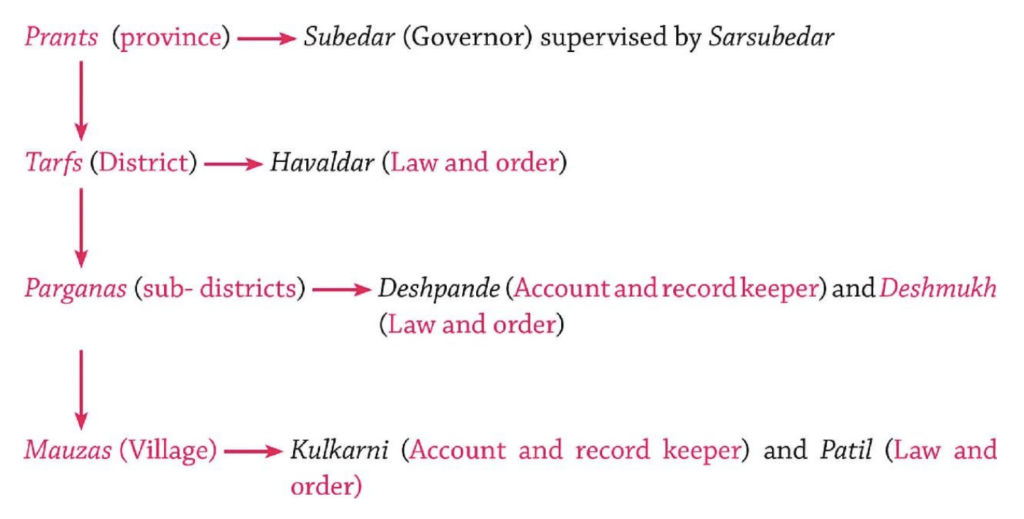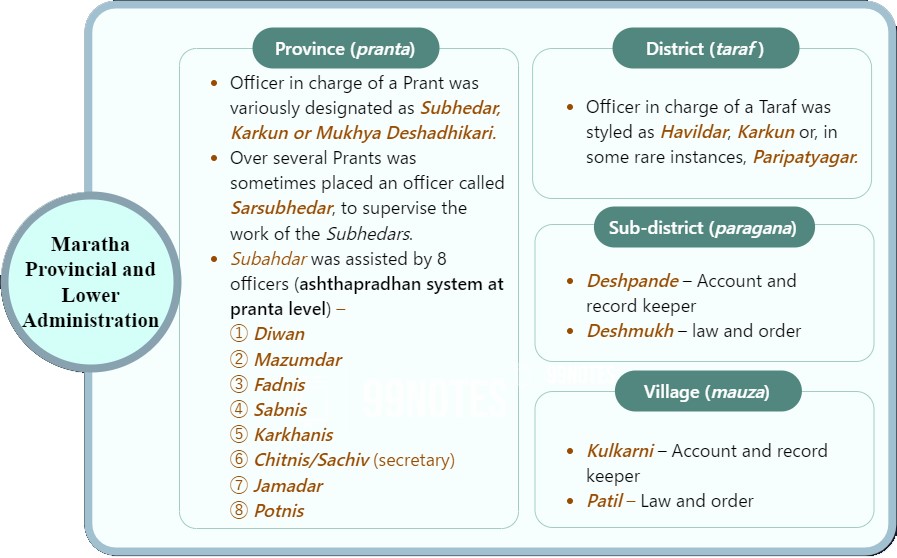- Shivaji was an outstanding administrator. He laid the groundwork for a solid administrative system. Shivaji was a fierce warrior who defied Mughal rule and conquests with Afzal Khan and Aurangzeb. The Maratha Empire of Shivaji extended from Maharashtra to Carnatic and Tamil Nadu.
- Shivaji’s dominion was divided into two sections: Mulk-i-qadim (ancient territory) or Swaraj (own kingdom), and an unspecified stretch of land that paid Chauth but was not subject to Shivaji’s authority. The Maratha Kingdom was known as Swarajya or Mulk-e-Kadim.
- To fortify the administration, Shivaji abolished the Jagir system and began paying his officers in cash. He provided land grants for schools and temples despite abolishing the Jagirdari system.
- The administrative system of the Marathas was very much influenced by the administrative system of the Mughals and the Deccani states (adopted by Malik Amber of Ahmednagar and Mahmud Gawan of Bahmani Kingdom).
Shivaji’s Administration
Central Administration
- The king was the pivot of the government, who was assisted by a council of ministers called the Ashtapradhan. Each one was directly responsible to Shivaji and headed a department. Under Shivaji, these offices were neither hereditary nor permanent and were also frequently transferred.
- Peshwa – Pant Pradhan, who looked after finance and general administration. Later, the office of Peshwa became more powerful and functioned more as the prime minister. There was great focus on Intelligence and a centralised intelligence department was created.
- Sar-i-Naubat or Senapati – Military commander, a honorary post.
- Amatya/Majumdar – Accountant General.
- Waqenavis – Intelligence and police, posts, historical archives, and household affairs.
- Surnavis or Chitnis or Sachiv – General Secretary who also overlooked official correspondence.
- Sumant/Dabir – Master of ceremonies and Foreign Affairs.
- Nyayadish – Justice.
- Pandit Rao – Charities and ecclesiastical affairs.
- Hierarchy of officers from top to bottom was:
- Peshwa → Majumdar → Sachiv → Mantri
- It is pertinent to note that all the ministers except Pandita Rao and Nyayadhish participated in war. The Ashtapradhan was not a creation of Shivaji and many of these officers such as Peshwa, Majumdar, Waqai navis, Dabir, and Surnavis had existed earlier under the Deccani rulers too.
- Each of the Ashtapradhan was assisted by eight assistants namely Diwan, Majumdar, Fadnis (used to respond to the letters of commanders of the forts), Sabnis, Karkhanis, Chitnis (dealt with all diplomatic correspondences and wrote all royal letters), Jamadar, and Potnis (looked after the income and expenditure of the royal treasury).
Provincial and Local Administration
- The provincial administration was also patterned largely on the Deccani and Mughal system. Shivaji reorganised and renamed certain provinces.
- The provinces were known as Prants, which were under the charge of the Subedar. The Sarsubedar used to control and supervise the work of the subedar.
- After Prants came the Tarfs, which were headed by a havaldar. Mauzas or villages were the lowest unit of administration.
- The police officer in rural area was called Faujdar and in urban area was called Kotwal.
- Under the Marathas, performance-based Brahmin elites called Kamvishdar manned the central bureaucracy and the local administration and used to enjoy wide powers of tax assessment and collection. They kept records, adjudicated cases, and provided information about local conditions to the superior officials.
- Interestingly, the office of British District Collector was modelled on the Kamvishdar.


Army Administration
- Shivaji was a military genius and his army was very well organised. The Marathas were pioneers of commando actions. The army consists of Infantry i.e. Mavali foot soldiers; Cavalry i.e. Horse riders and equipment holders; Navy.
- The ordinary soldiers were paid in cash, but big chief and military commander were paid through jagir grants (Saranjam or Mokasa).
- The regular standing army known as Paga consisted of about 30,000 to 40,000 cavalry supervised by the havaldar, who were given fixed salaries. The lowest head of the cavalry was called Naik.
- In fact, all the war horses belonged to the state. There were two divisions in the Maratha cavalry:
- Bargirs: Equipped and paid by the state
- Silahdars: Maintained by the nobles.
- The Marathas were famous for guerrilla warfare, along with the use of an innovative weapon, the Bagh naka, meaning tiger claw. The infantry was highly mobile and light, and the Mavli foot soldiers played an important role in the infantry.
- Interestingly, at the time of exigencies, peasants also functioned as part time soldiers as they used to work for eight months in the field and performed war duty in four months. Shivaji also built a powerful navy.
- By the end of his reign, Shivaji had about 240 forts and the forts played an important role in the military operations of the Marathas. Each fort was put under the charge of three officers of equal rank (Sabnis, Kardadar, Sar-i-naubat) for mutual check and as a precaution against treachery.
| Naik | The smallest unit of infantry |
| Havaldar | Head of five Naiks |
| Jumledar | Head of two to three Havaldars |
| Hazari | Head of ten Jumledars |
| Sarnobat (Senapati) | Head seven such Hazaris, Incharge of army (chief of Army) |
| Qiladars | Officers of Forts |
| Ghuraw | Boats laden with guns |
| Gallivat | Rowing boats 40-50 rowers |
| Paik | Foot Soldiers |
Navy
- Shivaji built a strong navy after his conquest of Konkan.
- His fleet was equipped with Ghurabs (gunboats) and Gallivats (row boats with two masts and 40-50 oars).
- His fleet was mainly manned by the Koli sea-fearing tribe of the Malabar coast.
- He also employed Muslims in his navy. Daulat Khan was one of his admirals.
- Shivaji used his naval power to harass both the indigenous and European traders. However, he could not check the menace of Siddis of Janjira, who worked for the Bijapur sultanate and later for the Mughals.
- The Peshwas also maintained a strong fleet to defend the western coast.
Judicial Administration
- Under Shivaji, the judicial system was simple, primitive, and crude. The system was founded on ancient Hindu rules.
- The highest court was the king’s ‘Hazar Majils.’
- The Panchayats handled disputes between various parties in the communities, and the village ‘Patil’ decided on criminal cases.
Revenue Administration
- The revenue system of Shivaji was also largely based on that of the Mughals and Deccani states such as that of Malik Amber of Ahmadnagar.
- Land was measured by using the measuring rod called lathi and were classified into three categories – paddy fields, garden lands, and hilly tracts.
- Shivaji drastically reduced the powers of the existing Deshmukhs and Kulkarnis and appointed his own revenue officials called karkuns. Shivaji strongly discouraged revenue farming.
- The Marathas employed a special script known as the ‘Modi script’ in the documents of the revenue and administrative records.
- Chauth and sardeshmukhi were two major sources of revenue and it is interesting to note that these taxes were collected not in the Maratha kingdom but in the neighbouring territories of the Mughal empire or Deccan sultanates.
- Chauth: One fourth (1/4 th of the land revenue) paid to the Marathas in order to avoid the Maratha raids.
- Sardeshmukhi was an additional levy of ten percent, that is, 1/10 of standard land revenue on those lands on which the Marathas claimed hereditary rights.
Conclusion
- Shivaji was a capable general and a skilled politician who laid the groundwork for a powerful Maratha empire. He expanded the Maratha Empire’s influence from the Deccan to Karnataka and elevated it to the level of all India.
- He established an efficient administrative system, established an authentic revenue system for income, and broadened the empire’s economic base through Chauth and Sardeshmukhi, a cash-based army, and so on.
- Shivaji was a true creative genius and nation-builder. His meteoric rise from jagirdar to Chatrapathi was breathtaking. He unified the Marathas while remaining a major foe of the Mughal empire. He was a fearless soldier and an astute administrator.
